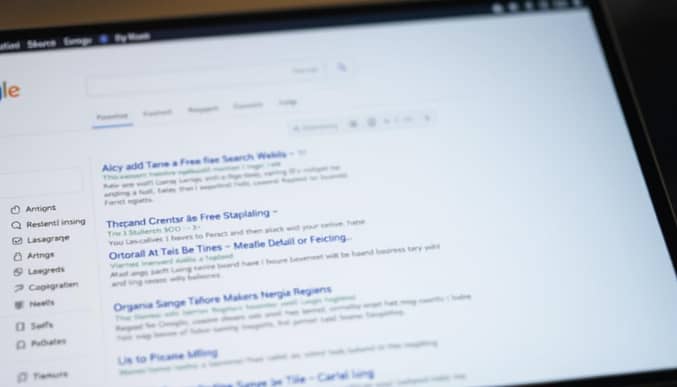Ultimate Guide: What Does SERP Mean? SEO Definition
When you type a question into Google, the list of links, images, and boxes that appear isn’t random. This search engine results page (SERP) is carefully curated using complex algorithms. For businesses and marketers, understanding how these pages work is critical for online success.
This guide breaks down SERP fundamentals. You’ll learn how search engines prioritize organic results based on content quality and relevance while mixing in paid ads. Over half of first-page results now include advertisements, creating fierce competition for visibility.
Mastering SERP dynamics helps optimize content for better rankings. Features like Featured Snippets or Local Packs – appearing in 58% of search results – require specific strategies. We’ll explore how ranking signals and user behavior shape these outcomes.
Key Takeaways
- SERP stands for the page displaying search results after a query
- Contains both unpaid organic listings and paid advertisements
- Google uses 200+ ranking factors to order results
- 51.6% of first-page results include ads
- Special features like Local Packs impact click-through rates
- Optimization requires understanding algorithm updates
Understanding Search Engine Results Pages
Every Google search triggers a dynamic assembly of results tailored to answer questions, solve problems, or guide decisions. A search engine results page (SERP) displays this mix of links, ads, and interactive elements. Its layout changes constantly based on location, device type, and past browsing behavior.
Definition and Overview
A SERP acts as a digital answer board. When users type a search query, algorithms scan billions of web pages to rank the most relevant content. Paid ads appear at the top and bottom, marked with “Sponsored” labels. Organic results follow, prioritized by quality and relevance.

Google’s SERP features like Knowledge Panels and Featured Snippets provide instant answers. These tools reduce the need to click through websites. For example, searching “weather in Chicago” shows a forecast box without requiring site visits.
User Experience and Query Context
Search engines personalize results to match intent. A “near me” query activates Local Packs with maps and business hours. Mobile users see more video carousels, while desktop displays emphasize text-based answers.
| Feature | Purpose | Example |
|---|---|---|
| Featured Snippet | Quick answers | “How to tie a tie” |
| Local Pack | Nearby businesses | “Coffee shops nearby” |
| Knowledge Panel | Factual summaries | “Eiffel Tower height” |
Understanding these elements helps businesses optimize content. A restaurant targeting lunch crowds needs Local SEO strategies. Tech blogs benefit from structuring answers for snippet eligibility. Aligning with SERP trends boosts visibility in competitive markets.
What Does SERP Mean in SEO?
The digital battleground for visibility began with simple text links in the 1990s. Search engines like AltaVista organized results into basic lists, prioritizing keywords over context. Over time, algorithm updates reshaped these pages into multi-layered answer hubs.

Origin and Evolution of SERPs
Early search engine results pages focused on matching exact phrases. Google’s 2003 Florida update penalized keyword stuffing, forcing websites to prioritize quality. The 2012 introduction of Knowledge Graph added factual panels, reducing clicks to external sites.
By 2015, mobile searches triggered Local Packs and map integrations. Today, voice search and AI-generated answers dominate. These shifts demand adaptive strategies beyond traditional tactics.
“SERPs evolved from ten blue links to personalized answer engines. Marketers must now optimize for position zero, not just page one.”
Why SERP Matters for SEO
Modern search results determine business success. Websites appearing in Featured Snippets receive 35% more clicks than standard listings. Local businesses rely on map placements to drive foot traffic.
| Past SERP Features | Current SERP Features | Impact |
|---|---|---|
| Text-only links | Video carousels | +42% engagement |
| Static ads | Interactive shopping panels | Higher conversion rates |
| Basic meta descriptions | Rich snippets with ratings | Improved CTR |
Optimizing for today’s search engine results requires technical precision. Backlink quality and mobile-first design now outweigh keyword density alone. Brands mastering these shifts dominate their niches.
The Anatomy and Key Features of SERPs
Today’s search engine results pages blend paid promotions, organic listings, and interactive tools to deliver instant answers. These components compete for attention while addressing different user needs.
Organic Versus Paid Results
Paid ads dominate the top and bottom of search engine results pages. Marked with “Sponsored” labels, these listings let businesses buy visibility for competitive keywords. In contrast, organic results rely on relevance and content quality to earn their positions.
| Organic Results | Paid Ads |
|---|---|
| Earned through SEO | Purchased via PPC |
| No cost per click | Budget-dependent |
| Long-term visibility | Immediate placement |
Mobile users see 4-6 ads before organic content. Desktop layouts often mix both types, creating a visual tug-of-war for clicks.
SERP Features and Enhancements
Modern search results include dynamic elements that reshape user behavior:
- Knowledge Panels: Display facts about brands or topics
- Image Packs: Show visual answers for queries like “interior design ideas”
- People Also Ask: Expands search intent with related questions
These tools reduce website visits but boost engagement. A bakery appearing in Local Pack results gets 3x more store visits than standard listings. Video carousels now dominate 19% of product-related searches.
Optimizing for these features requires balancing technical SEO with creative content strategies. Structured data markup helps content qualify for rich snippets, while geo-targeting improves Local Pack eligibility.
How SERPs Work and Influence Ranking
Behind every Google search lies a complex evaluation process. Search engines analyze over 200 factors to rank pages, balancing technical precision with user needs. This system evolves constantly, requiring businesses to adapt strategies for visibility.
Search Engine Algorithms and Ranking Signals
Modern algorithms like Google’s RankBrain use machine learning to interpret ambiguous queries. When someone searches “best running shoes for flat feet,” the system evaluates content relevance, backlink authority, and user engagement metrics. Pages satisfying these criteria appear higher in results.
Three core signal types shape rankings:
| Signal Type | Examples | Impact Level |
|---|---|---|
| On-Page | Content relevance, header tags | High |
| Off-Page | Backlinks, social shares | Critical |
| User Behavior | Click-through rates, dwell time | Moderate-High |
Algorithm updates frequently shift priorities. The 2015 Mobilegeddon update prioritized mobile-friendly sites, while Core Web Vitals now assess page speed. Businesses monitoring these changes adjust SEO tactics to maintain rankings.
High-quality content remains non-negotiable. Pages answering questions thoroughly earn longer visits and social shares. Combined with strategic keyword placement, this approach satisfies both algorithms and human readers.
“Ranking isn’t about tricking systems—it’s about aligning with what search engines reward: helpful, authoritative content.”
Enhancing Visibility Through SEO and SERP Optimization
Businesses competing online need more than quality content—they require strategic alignment with search engine priorities. Winning SERP visibility demands balancing technical precision with creative audience engagement. This dual approach separates temporary gains from sustainable growth.
On-Page SEO Techniques for Better SERP Placement
Start with keyword research to identify phrases your audience uses. Tools like Google Keyword Planner reveal search volume and competition levels. Craft meta titles under 60 characters and descriptions under 160 to avoid truncation.
Header tags (H1-H3) should structure content while incorporating primary keywords naturally. Optimize images with descriptive alt text—search engines can’t “see” visuals without it. Mobile-friendly designs load faster, satisfying Google’s Core Web Vitals metrics.
Local businesses thrive by embedding geographic keywords. A Portland bakery increased organic traffic 78% by adding “artisan donuts near me” in headers and content. Regular site audits fix broken links and improve crawl efficiency.
Off-Page Strategies and Content Marketing
High-quality backlinks remain the currency of domain authority. Guest posts on industry sites and partnerships with influencers build credibility. Social bookmarking platforms like Reddit drive referral traffic when content solves specific problems.
Video tutorials and infographics boost engagement. A skincare brand gained 200% more clicks by adding explainer videos to product pages. Share content across platforms—LinkedIn articles perform well for B2B audiences.
Combining these tactics creates a multiplier effect. Companies using comprehensive SEO and SERP visibility strategies maintain top positions through algorithm changes. Success requires constant adaptation, not one-time fixes.
Conclusion
Mastering search engine results requires strategic adaptation to evolving digital landscapes. The transformation from basic link lists to interactive answer hubs demands SEO optimization that balances technical precision with user intent. Businesses prioritizing mobile-first designs and structured data markup gain visibility in features like Featured Snippets and Local Packs.
Organic and paid results serve distinct roles. While ads offer immediate placement, content quality and backlink authority drive lasting organic growth. Google’s ranking algorithms reward pages answering queries thoroughly, as seen when a bakery boosted traffic 78% by optimizing geo-specific keywords.
Staying competitive means monitoring search engine updates and user behavior trends. Brands leveraging video content or rich snippets see higher engagement, with Featured Snippets capturing 35% more clicks than standard listings. Regular audits and adaptive strategies ensure sustained performance.
Invest in data-driven SEO practices to secure prime positions. Analyze click-through rates, refine meta tags, and prioritize mobile responsiveness. As search tools evolve, continuous learning remains key to maintaining visibility in this dynamic arena.